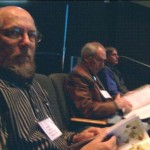
I arrived in Reno, Nevada on Monday, about two and a half hours after leaving Mono Lake. The best year ever for fall color was moving downhill, and while the Mono Basin still held pockets of intensely colored leaves, Topaz was now the epicenter of the color with the beautiful giant cottonwoods along the highway blazing with color and dropping many yellow leaves on Highway 395.
I checked in to the International Symposium on Terminus Lakes at the Silver Legacy Hotel, where most conference participants were staying. After chatting with the bartender about our mutual experience with solar photovoltaics on our respective homes, I sat down, had some appetizers, and looked over the conference program. An impressive lineup of speakers and 20-minute presentations were awaiting us over the next two days at the University of Nevada, Reno. Sitting a couple of tables away, I recognized Sudeep Chandra from the previous week’s Sierra Nevada Alliance Conference—an SNA board member and limnologist who briefly spoke eloquently about Mono Lake at that conference. Photos of Mono Lake are also featured prominently on the symposium’s Website.
Peter Vorster, our consulting hydrologist, when he saw the name of the symposium a month or two before, asked if they are using “terminus” instead of “terminal” because “terminal” evokes death? It is interesting to see the traditional term “terminal” changed, and perhaps this is a wise change in terminology since many terminal lakes are endangered. Also interesting—and a bit cryptic—was the slogan on the water bottles received by each symposium participant: “blue is the new green.”
I left the Silver Legacy and went to my friend Mike Klapp’s house, where I would stay for the next two days. His house is literally a stone’s throw from the Truckee River—closer than the Mono Lake Committee Information Center and Bookstore is to Lee Vining Creek—and within a couple of minutes of walking to the river we saw a kingfisher, and later that evening we saw a Black-crowned Night Heron sitting on a rock in the middle of the river. Some ducks floated down the river on water that was making its way from Lake Tahoe to Pyramid Lake—a large desert terminal lake like Mono, but unlike Mono Lake it has a freshwater fishery that was saved from excessive diversions two decades ago, thanks to the Endangered Species Act.
The next morning, I walked to the bus stop along the river at dawn. I passed the whitewater kayak park—Reno has a very nice riverfront that draws crowds in the summer to cool off and play in the water. It made me think that a spot like this could easily be built in the LA River and be such a valuable amenity to the nearby communities. Communities that embrace their riverfronts always seem so vibrant, and are natural places for people to fall in love with rivers and learn to protect them.

I rode on the bus to the university with Bob Jellison and Kim Rose, who study Mono Lake’s limnology. Bob has been studying Mono Lake for over two decades. And we sat down in the same row as Scott Stine, who is currently staying at the Mono Basin Field Station while he conducts his Mono Basin research, and Don Sada, who recently was featured in a nice High Country News article that talked about his work on Great Basin spring snails.
Several opening remarks were made, including ones from the University president, Milton Glick, whom those of us NPR listeners in the Eastern Sierra would recognize from his regular appearances on Morning Edition on KUNR, the local NPR station. The keynote speaker was Wally Broecker, who began his research in the Great Basin and has dire predictions for the area if we fail to control our CO2 emissions.
Coming Soon: Terminus Lakes Symposium Part 2—Climate Change could cause the Great Basin to become much drier
